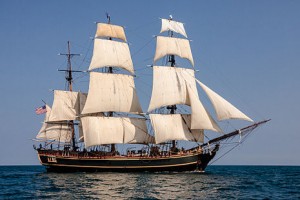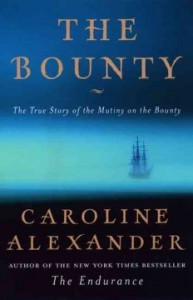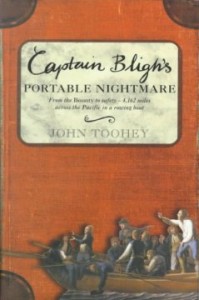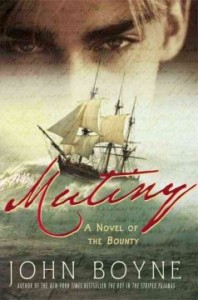June 14th is typically associated with Flag Day in the United States, commemorating the adoption of the ‘Stars and Stripes’ flag by the Second Continental Congress in 1777. But there are other reasons for remembering the date: for example, it just so happens that yesterday, June 14, was the 226th anniversary of the return to England by Captain William Bligh, and the survivors of the loyal crew of the now-infamous H.M.S Bounty.

The Bounty set sail in April of 1787, charged with transporting breadfruit plants from Tahiti to the British West Indies (so named because they taste a bit like potatoes, and smell like bread). The crew was comprised of 44 British navy-men and 2 botanists. Among these young men was a twenty-three-year old named Fletcher Christian, who had sailed with Captain William Bligh twice before, forming a fairly close teacher-student relationship.

The trip proved a difficult one. After being held up by weather, the crew had to wait nearly five months for the breadfruit to properly ripen before it could be taken on board, until April, 1789. Though all this delay made Bligh anxious to head back home, there is no doubt that his men were enjoying themselves most heartily in Tahiti, and relishing the relaxed discipline.
What happened next is well known to history: Fletcher Christian led a bloodless mutiny aboard the Bounty at approximately 5:15am on April 28, 1789, agreeing to put as many of those who remained loyal to Bligh as would fit into 23-foot launch-boat with five days’ worth of food, rather than kill them. What we still don’t know for sure, is why. Some say it was because Bligh’s disciplinary attitude aboard ship had become downright tyrannical, and his paranoia so profound that he was judged to be putting the ship and her crew in jeopardy (this story was first put forth by one of Christian’s descendants). However, the Bounty’s log books show that Bligh was fairly lenient in his command. In fact, some argue it was this very leniency that got him into trouble.
The story of the little launch is a stunning one: When his attempts to get help and supplies from some nearby natives proved fruitless, Bligh–thanks to the navigational skills he learned under Captain Cook–piloted the tiny boat 3,618 nautical miles, from Tahiti to Timor, and from there, another 544 miles to what is now Jakarta, Indonesia, where he was able to secure proper transport home to England. He accomplished this with no maps, no charts, and almost no food, using the stars and the sun alone as his guide.
In comparison, the group of mutineers divided within months, with 16 men remaining in Tahiti, where they were captured in 1791 by Captain Edward Edwards, whose ship, the HMS Pandora had been sent especially for them. When the Pandora ran aground on the Great Barrier Reef, six of the men died, while the rest were forced to travel in a open boat, much like the one Bligh had been forced to use. They were court-martialed in England in September of 1792, and ultimately, three were hanged for treason.
The eight men who remained with Christian set sail for Pitcairn Island, landing on January 15, 1790, and forming a settlement with their Tahitian wives and several other natives. However, the Tahitians, who the British men saw more as ‘property’ than fellow settlers, rose up, killing five of the Bounty men, including Christian, in 1794. Several more years of violence and unrest followed until only one member of the Bounty, named John Adams, was left in charge of the community. They were discovered by an American ship, the Topaz in 1808, which related the discovery of the Bounty‘s final home to the British. Rather than punish those who now lived on Pitcairn, the British decided to use them to their own advantage, modeling the society as a model of Christianity and morality–the perfect British settlement, despite its origins.
For those of you looking to know more details about the Bounty, the Mutiny, or the people involved, here are some sources to check out, and a few to keep the armchair adventurers entertained!
 The Bounty: The True Story of the Mutiny on the Bounty: Caroline Alexander’s thoroughly engaging book is probably the best on the subject, bringing together generations of history in order to get as close to the truth as possible about that fateful night, and the events that took place afterwards.
The Bounty: The True Story of the Mutiny on the Bounty: Caroline Alexander’s thoroughly engaging book is probably the best on the subject, bringing together generations of history in order to get as close to the truth as possible about that fateful night, and the events that took place afterwards.
 Captain Bligh’s Portable Nightmare: John Toohey’s work is primarily concerned with Bligh’s navigational feats after he was put off the Bounty, and emphasizes the genuinely overwhelming accomplishment that Bligh achieved in getting to Jakarta without maps or compass. He also deals with the trial Bligh faced on his return for losing his ship, and his redemption in the Napoleonic Wars.
Captain Bligh’s Portable Nightmare: John Toohey’s work is primarily concerned with Bligh’s navigational feats after he was put off the Bounty, and emphasizes the genuinely overwhelming accomplishment that Bligh achieved in getting to Jakarta without maps or compass. He also deals with the trial Bligh faced on his return for losing his ship, and his redemption in the Napoleonic Wars.
 Fragile Paradise: The Discovery of Fletcher Christian, Bounty Mutineer: This study of Fletcher Christian, written by his great-great-great-great-grandson, is not only the tale of a mysterious mutineer, but also a great travel adventure in its own right. It is also one of the first works to give credit to the Tahitian women who sailed to Pitcairn, and the vital role they played in keeping the settlement alive.
Fragile Paradise: The Discovery of Fletcher Christian, Bounty Mutineer: This study of Fletcher Christian, written by his great-great-great-great-grandson, is not only the tale of a mysterious mutineer, but also a great travel adventure in its own right. It is also one of the first works to give credit to the Tahitian women who sailed to Pitcairn, and the vital role they played in keeping the settlement alive.
 Mr. Bligh’s Bad Language: A fascinating analysis of Bligh’s abilities as a Captain, and how his behavior could have contributed to the mutiny, as well as a fascinating study of power and performance in the world in which these men lived.
Mr. Bligh’s Bad Language: A fascinating analysis of Bligh’s abilities as a Captain, and how his behavior could have contributed to the mutiny, as well as a fascinating study of power and performance in the world in which these men lived.
 Lost paradise : from Mutiny on the Bounty to a modern-day legacy of sexual mayhem : the dark secrets of Pitcairn island revealed:
Lost paradise : from Mutiny on the Bounty to a modern-day legacy of sexual mayhem : the dark secrets of Pitcairn island revealed:
Despite being aggressively titled, this book is highly readable, though deeply unsettling account of the later history of Pitcairn Island that begins in 2000, when British authorities were sent to the island (which remains the last holding of the British in the Pacific) to investigate the rape of a fifteen-year-old girl. Kathy Marks was one of only six journalists sent to cover the subsequent trial, and her account, though not always easy to read, is a necessary addition to the story of the Bounty and its legacy.
 Mutiny: a novel of the Bounty: Crack ghost-story authorJohn Boyne turns his talents to historical fiction in this tale of Jacob Turnstile, a young man who escapes prison by accepting a position aboard the Bounty. This tale for teens is a terrific adventure, as well as a fascinatingly complex study of human morality and strength.
Mutiny: a novel of the Bounty: Crack ghost-story authorJohn Boyne turns his talents to historical fiction in this tale of Jacob Turnstile, a young man who escapes prison by accepting a position aboard the Bounty. This tale for teens is a terrific adventure, as well as a fascinatingly complex study of human morality and strength.
 C.S. Forrester’s Hornblower: Ok, so it’s not precisely the Bounty, but this captivating mini-series adaptation of C.S. Forrester’s classic novels fo the British Navy (starring the very young, but still very watchable Ioan Gruffudd) features all the period detail and historical tidbits one could want out of a Napoleonic War piece. Come on…they built a full-scale, completely accurate ship of the line specifically for the show. Best of all, episodes Five and Six center around an alleged mutiny, thus allowing for the phrase “Black, bloody mutiny!” to be bellowed at regular intervals.
C.S. Forrester’s Hornblower: Ok, so it’s not precisely the Bounty, but this captivating mini-series adaptation of C.S. Forrester’s classic novels fo the British Navy (starring the very young, but still very watchable Ioan Gruffudd) features all the period detail and historical tidbits one could want out of a Napoleonic War piece. Come on…they built a full-scale, completely accurate ship of the line specifically for the show. Best of all, episodes Five and Six center around an alleged mutiny, thus allowing for the phrase “Black, bloody mutiny!” to be bellowed at regular intervals.
